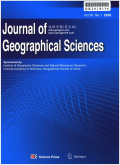- 钛学术文献服务平台 \
- 学术期刊 \
- 基础科学期刊 \
- 天文学、地球科学期刊 \
- 地理学报(英文版)期刊 \
Spatial evolution and growth mechanism of urban networks in western China:A multi-scale perspective
Spatial evolution and growth mechanism of urban networks in western China:A multi-scale perspective
基本信息来源于合作网站,原文需代理用户跳转至来源网站获取
摘要:
Globalization and informatization promote the evolution of urban spatial organiza-tion from a hierarchical structure mode to a network structure mode,forming a complex net-work system.This study considers the coupling of"space of flows"and"spaces of places"as the core and"embeddedness"as the link and a relevant theoretical basis;then we construct a conceptual model of urban networks and explore the internal logic of enterprise networks and city networks.Using the interlocking-affiliate network model and data from China's top 500 listed companies,this study constructs a directed multi-valued relational matrix between cities in western China from 2005 to 2015.Using social network analysis and the multiple regres-sion of quadratic assignment program model(MRQAP),this study adopts a"top-down"re-search perspective to analyze the spatio-temporal evolution and growth mechanism of the city network in western China from three nested spatial scales:large regions,intercity ag-glomerations,and intracity agglomerations.The results show the following:(1)Under the large regional scale,the city network has good symmetry,obvious characteristics of hierar-chical diffusion,neighborhood diffusion,and cross-administrative regional connection,pre-senting the"core-periphery"structural pattern.(2)The network of intercity agglomerations has the characteristics of centralization,stratification,and geographical proximity.(3)The internal network of each urban agglomeration presents a variety of network structure modes,such as dual-core,single-core,and multicore modes.(4)Administrative subordination and economic system proximity have a significant positive impact on the city network in western China.The differences in internet convenience,investment in science and technology,aver-age time distance,and economic development have negative effects on the growth and de-velopment of city networks.(5)The preferential attachment is the internal driving force of the city network development.

推荐文章
Assessment of bacterial biomass in the highly contaminated urban Nanming River, Guiyang, SW China
δ13C
δ15N
Bacterial biomass
N budget
Nanming River
The mixing of multi-source fluids in the Wusihe Zn–Pb ore deposit in Sichuan Province, Southwestern
Sichuan–Yunnan–Guizhou
Wusihe Zn–Pb deposit
Zn–S isotopes
Fe–Cd contents
Two-source fluids
内容分析
关键词云
关键词热度
相关文献总数
(/次)
(/年)
引文网络
引文网络
二级参考文献 (0)
共引文献 (0)
参考文献 (0)
节点文献
引证文献 (0)
同被引文献 (0)
二级引证文献 (0)
2022(0)
- 参考文献(0)
- 二级参考文献(0)
- 引证文献(0)
- 二级引证文献(0)
引文网络交叉学科
相关学者/机构
期刊影响力
地理学报(英文版)
主办单位:
中国地理学会
中国科学院地理科学与资源研究所
出版周期:
月刊
ISSN:
1009-637X
CN:
11-4546/P
开本:
16开
出版地:
北京安外大屯路甲11号
邮发代号:
创刊时间:
1990
语种:
eng
出版文献量(篇)
1776
总下载数(次)
1
总被引数(次)
12509
期刊文献
相关文献
推荐文献
- 期刊分类
- 期刊(年)
- 期刊(期)
- 期刊推荐
力学
化学
地球物理学
地质学
基础科学综合
大学学报
天文学
天文学、地球科学
数学
气象学
海洋学
物理学
生物学
生物科学
自然地理学和测绘学
自然科学总论
自然科学理论与方法
资源科学
非线性科学与系统科学
地理学报(英文版)2022
地理学报(英文版)2021
地理学报(英文版)2020
地理学报(英文版)2019
地理学报(英文版)2018
地理学报(英文版)2017
地理学报(英文版)2016
地理学报(英文版)2015
地理学报(英文版)2014
地理学报(英文版)2013
地理学报(英文版)2012
地理学报(英文版)2011
地理学报(英文版)2010
地理学报(英文版)2009
地理学报(英文版)2008
地理学报(英文版)2007
地理学报(英文版)2006
地理学报(英文版)2005
地理学报(英文版)2004
地理学报(英文版)2003
地理学报(英文版)2002
地理学报(英文版)2001

 免费查重
免费查重










